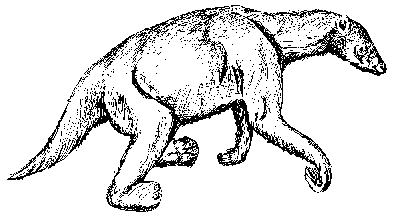

In the late 1920s, Boy Scouts were exploring an extinct fumerole in southern New Mexico's Aden Crater Volcanic Field. Near the bottom of this 100-foot-deep volcanic vent, they found the complete skeleton of the extinct, bear-sized Shasta Ground Sloth partially buried in bat guano. It undoubtedly had stumbled, perhaps in the dark, into the small opening on the surface.
By studying the sloth's feces, scientists were able to determine
what it had eaten for its last meal. Even more intriguing, the skeleton also turned out
to retain patches of skin, hair, and other tissues preserved by burial in guano and the
dryness of our Chihuahuan Desert. The mere presence of these materials fueled
speculation that extinction had to occur only a few hundred years ago. However, many
years later, radiocarbon dating determined that the sloth's dive into destiny
happened over 11,000 years ago.

Listen to the Audio (mp3 format) as recorded by KTEP, Public Radio for the Southwest.
Contributor: Arthur H. Harris, Laboratory for Environmental Biology, University of Texas at El Paso.
Desert Diary is a joint production of the Centennial Museum and KTEP National Public Radio, University of Texas at El Paso.

Shasta Ground Sloth. Redrawn from Lull, 1929.
Lull, R. S. 1929. A remarkable ground sloth. Memoir, Peabody Mus., Yale Univ., 3, pt. 2:i-x + 1-39.
Stock, C. 1992. Rancho La Brea, A Record of Pleistocene Life in California. Seventh Edition (revised by J. M. Harris). Natural History Museum of Los Angeles County, Science Series, no. 37, 113 pp.